How to find someone else's soap
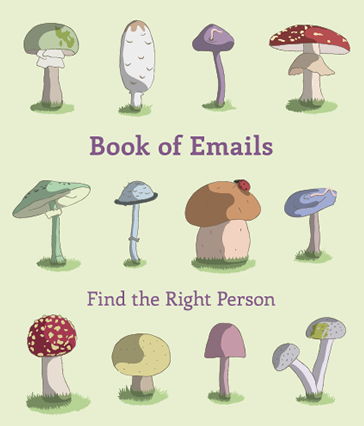
The manual contains a description of the search for personal and corporate email using various methods using special services and search engines. Includes practical examples of email search and recommendations for beginners.
1. General information about corporate and personal email
Theoretically, email addresses (email) can be divided into email sites and personal.
1. Email sites - "impersonal" email addresses of sites, traditionally tied to the site domain. There are established rules by which they are created:
- info domen .com - main email site
- sales domen .com - sales department
- editorial domen .com, editor domen .com - editor
- webmaster domen .com - webmaster
- feedback domen .com, contact domen .com - email for communication
- support domen .com - support service
- subscribe domen .com - technical email exclusively for subscribing to news, updates, etc.
- custserv domen .com, customerservice domen .com - service ordering goods or services
- admissions @, library @, registrary @, enquiries @ are typical components of universities and colleges email (for example, http://www.cam.ac.uk/global/contact.html )
Examples of the use of corporate email formats are in Appendix 2.
The ratio of various corporate email formats for the period of the development of the Internet has changed significantly.
The main change is a sharp increase (almost 4 times) in the number of emails that are tied to a domain, but have a non-standard format, at the expense of virtually all others. More than 60% decrease in the number of email format feedback @, admin @ and webmaster @. These changes are closely related to the development of the Internet itself. The first and most important thing is accessibility in the creation and placement of sites. So, even a schoolboy or housekeeper can create and maintain a small site, and there is a large selection of inexpensive and free hosting sites for hosting. In addition, the use of standard email formats at times increases the likelihood of it getting to spammers.
Email format editor @ lost its position less than others (27%) due to the fact that electronic media have gained great development in the network.
Commercial structures are also increasingly entering the Internet, creating websites for presenting their organizations in the network and selling goods and services. The share of such email increased by 19%.
The presented statistics are collected on the basis of 54,000 corporate email. The error is 5%. A detailed table is in Appendix 1.

On sites that are supported by a constant group of people, personal emails are created that are linked to a domain. The share of registered email has decreased by 28%, but still accounts for almost one fifth of all corporate email. This is most likely due to the convenience in creating such formats, especially in organizations with a large number of employees.

2. Personal email is most often associated with the postal services of search engines and is associated with the name and surname of the owner. For example, the standard type of personal email on gmail.com is username@gmail.com.
The largest are three mail services: gmail.com, yahoo.com, hotmail.com. According to statistical data, the ratio of the number of email services posted on the websites of these postal services has not changed significantly over the years. The data are collected on the basis of 4500 contact emails, the error is 5%.

Search email sites and personal email has its own characteristics.
2. Search email sites
You can search for email sites using three methods:
- On the site pages
- According to the service Who is
- Using search queries
The table shows the approximate ratio of these methods in a random sample of sites of various subjects and parameters. The search began with the pages of the site, then the Who is service, then using search queries. This is the optimal scheme to reduce search time. On average, an email search for search queries takes 2-3 times longer than the time to browse the necessary pages of the site.
| Where emails are found | % | % |
| On the site pages | 62 | |
| of them: | ||
| on the pages "Home", "Contact", "About", "Feedback" | 61 | |
| on the Privacy Policy page | sixteen | |
| on other pages (“Terms of Use”, “Media”, “Event”) | 23 | |
| Through the service www.who.is (non-technical) | 20 | |
| reference: | ||
| "Good" - corporate or personal email owner | 67 | |
| “Bad” - technical (hostmaster @, dns @) | 23 | |
| Using search queries | sixteen | |
| of them: | ||
| using standard search queries like domen.com email, site: domen.com intext: domen .com, site: domen.com intext: @ | eight | |
| using complex queries (analysis of information on the site, search by owner and participants of the project) | eight | |
| Could not be found (sites that have not been updated for more than 8 years on sub-domains, the owner of which could not be established) | 2 |
Let us consider in more detail each of these methods.
2.1. Site search
Search email begins with a search on the pages of the site. Most often emails are placed on the pages “Home”, “Contact”, “About”, “Feedback”, “Privacy Policy”. Contacts placed on the Privacy Policy page should be treated with caution, because They can use technical emails (for example, copyright @, copyrightagent @, privacy @).
Most often, contacts on the pages of sites can be found
- on news sites - 94%
- 84% on the websites of organizations and enterprises
- on sites of small commercial organizations providing services - 86%
- sites of universities, colleges and government agencies - 100%
On personal, educational information and online stores, emails are placed on average 50%. In other cases, offer a link through the contact form.
On average, the search on the site takes 1-2 minutes.
To simplify the search is convenient to use the function "search" for the browser. It is called by hot keys Ctrl + F (more about hot keys for different operating systems on http://en.wikipedia.org/wiki/Table_of_keyboard_shortcuts - “Go to find”). If the @ symbol is inserted into the search box that appears, the browser will show all available characters on the page.
However, on average, in 10-15% of cases, this does not work because site owners do not place such information openly, protecting their contacts from falling into the spam lists. Robots that collect email from the pages of sites are guided by the @ symbol and by a part of the code containing a link to an email of the form <a href=laymailto:...>. Therefore, site owners resort to tricks, placing email coded.
An average of 10% of emails placed on pages are protected in various ways:
- using a script- 60%
- encoding - 20%
- in other ways - 20%
A complex script that breaks the email in the page code into parts is considered one of the reliable ways to protect against spam-bots. On the page of this email is difficult to notice immediately, because it is hidden under the last name, the word "Email", a picture by which the user must guess what to look for exactly here (most often in the form of an envelope). If an email is found, you need to right-click on the link, in the window that appears, select "Copy email address" and paste the found email into any text document.

')
2.1.1. Coded email
Replacing the basic email characters "@" and "." Is one of the most common encoding methods. Thus, about 8% of email sites are encoded. For example, email of this type:
westra at mso dot anu dot edu dot au after replacing at with @ and dot with. (point)
acquires the standard view westra@mso.anu.edu.au.
The options can be very different, for example, ej * AT * eviljeff-DOT-com - ej@eviljeff.com.
Another variant of the encoding is the part of the text contained in the email that should be deleted. For example, in meREMOVE@mydomain.com you should delete REMOVE. Similar to email me@NOSPAM.mydomain.com, me@SPAM.mydomain.com, me@Delite_This.mydomain.com contain parts that should be removed.
The desire to protect themselves from spam has given rise to various combinations of these methods, sometimes reaching the point of absurdity.
henderso [the-at-symb] cs.columbia.edu
"Holly.hsb (at) (attempting to alleviate spam) highoctavehealing.com"
datafriend @ gmail -.- com
venomdoc666 [change this to @] gmail [insert period here] com
queries ((that little "at" thingie)) theoldentimes ((the dot thingie)) com
webmaster [~ at ~] ediblelandscaping.com
confi rt@onediblelandscaping.com
breadbox [whirlpool] muppetlabs [spot] com
PhrozenSmoke ['at'] yahoo.com
thomas (at) crampton dot com
business [attherateof] a2zknowledgevisuals [dot] com
webmaster (at) geeknativ + e (dot) co + m
bs (@t) noonanco.com
info- @ -petris -.- com
miyata [atmark] med.tohoku.ac.jp
"Encrypted" email in this form can be indexed by search engines. For example, there is no baris@barisderin.com in Google search results, but baris (at) barisderin.com does. This can be used when searching for email through search engines.
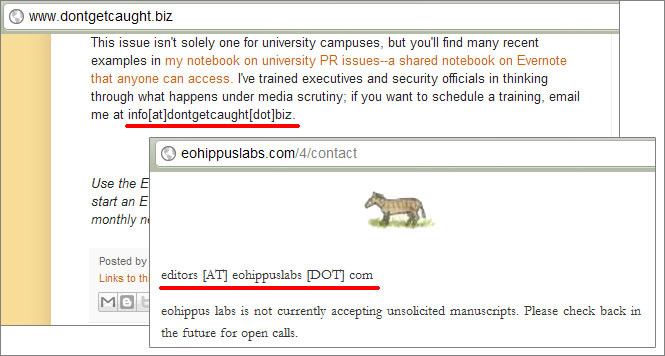
2.1.2. Placing email as a picture
In the form of images on the sites posted about 3% email. In this case, the email may not be displayed in the issuance of search engines.

Email in the form of a picture is usually placed on contact pages. This method is used not only by owners of small sites, but also by fairly large sites that hide contact information not from users, but from spam robots. Such emails cannot be copied from the page in text format, they can only be rewritten manually.

Sometimes the picture does not hide the entire email, but only the @ symbol. For example, on http://www.cse.scitech.ac.uk/database/staff.jsp?forename=john&surname=purton . In this case, you need to be careful when copying, because The email is transferred without the @ symbol (in the example, john.purtonstfc.ac.uk).

The following encoding methods are used by large specialized sites or communities with a large number of participants to encode personal emails located on the site.
2.1.3. Encoding of the form firstname.lastname domen .com
Write email in the form of firstname.lastname domen .com. In this case, firstname must be replaced with the name, and lastname with the last name.

In this example, the email from Martina Prochazka will look like a-Martin.Prochazka@casualconnect.org.
2.1.4. Encoding with captcha
Programmers' websites often use a different encoding method, when a part of the email can be read only after the introduction of a captcha.
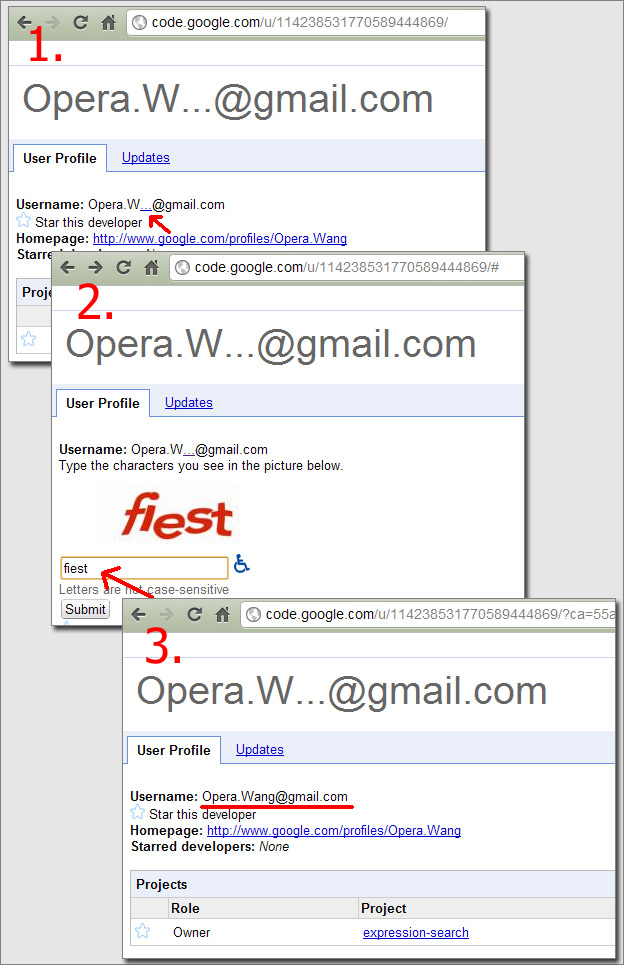
A similar method is used on web.archiveorange.com/archive/v/vz5lXpiL0zTcQnLEJcMq .
Sometimes developers hide emails in places inaccessible to the average user, on pages that are not allowed to be scanned by search engines, or in service files robots.txt. Such situations are extremely rare, not more than 1% of cases. For example, http://www.facebook.com/robots.txt .
2.2. Search using search queries
Sometimes the site owner places contacts on "off-standard" pages. In this case, we use the search with the help of search queries.
Let us dwell on some rules for creating search queries.
Two types of queries are usually used to search for an email site.
- domen.com email - the issue will be the pages of sites where there is a combination of a domain and email.
- site: domen.com intext: domen .com is a search query that is compiled using Google operators. “Site”, “intext” - operators, “domen.com”, “ domen. Com” - keywords. Between the operator and the keyword is a colon without a space. The search will be limited to the pages of the specified domain containing a specific query, in our case - domen .com, i.e. part of corporate email.
Consider the example of the site http://www.newzoo.org/ .
On the main and on the page "About Us" email no. Create a request for Google site: newzoo.org intext: @ newzoo.org
In issuing a search, there is one email volunteer@newzoo.org, which is posted on the internal pages of the site.
In the issue of the second request for newzoo.org email, we found another, more preferred email info@newzoo.org. The second query in this case gave the best result. The search took place throughout the network, and not only on the pages of the site itself.
Search using search queries is the main search for personal email. You need to understand that there is no single universal recipe, and for each specific situation you can make a request that meets it. Below will be considered similar examples.
2.3. Search service Who is
Sometimes the owner does not place email at all on the pages of the site, but uses a contact form for communication or links to social networks. In 48% of cases, email can be found on the service www.who.is.
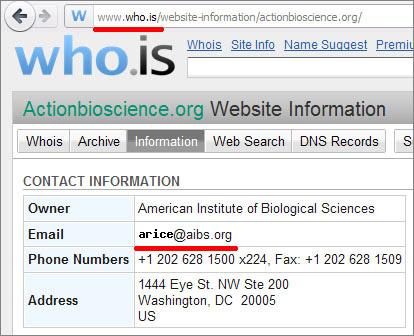
There are similar services that provide data about the site owner, for example, http://www.showsiteinfo.appspot.com/ , http://websitetrafficestimator.com/ . However, there are some pitfalls. Addresses like hostmaster @; domain_administrators @; dnsadmin @; domainadmin @; @ domainactive.com; @ domainbank.com; @ domaindiscreet.com; @ domainsbyproxy.com; @ whoisguard.com; @ whoisprivacyprotect.com are technical. On average, about 30% of those collected through this email service are not suitable for communication.
If you have to search for a large number of email addresses, it makes sense to install the Google Chrome SEO Site Tools browser plugin. On the Server / Domain Info tab, you can view the necessary information without going to the service site itself.
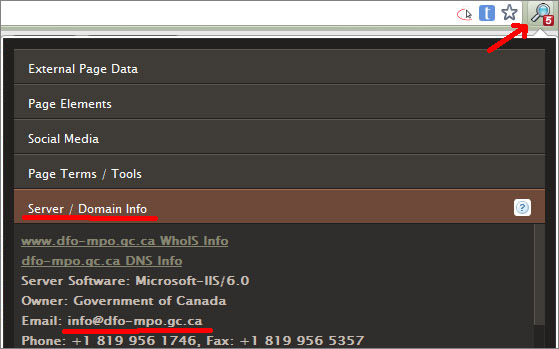
2.4. Search by email-format.com service
To search for corporate emails of US companies, you can use the email-format.com service. According to the owners, it contains a large database. The service has a clear interface. You can search using the search box or by selecting the organization you want in the alphabetically listed list.
For example, for
- www.olivetti.com (http://email-format.com/d/olivetti.com/)- 8 personal emails were found;
- www.omejo.com (http://email-format.com/d/omejo.com/) - corporate email. It is not on the specified page, but checking through Google shows that the email is valid;
- www.olympus-europa.com (http://email-format.com/d/olympus-europa.com/) - more than 30 personal and corporate email.
3. Search for personal email
3.1. Search for personal email on services
Any Internet user has a personal email, and sometimes not one. To facilitate the search, there are several services: http://people.yahoo.com/ , http://about.me/search/ , http://www.spokeo.com/ , http://www.123people.com/ , http://www.yasni.com/ , http://peoplesearch.whowhere.com/people/ , http://www.iaf.net/ , http://www.four11.com/ , http: / /www.lookup.com/ . These services have different search algorithms. But for the user, the search principle is the same for everyone - you need to enter the first and last names in the search field and look for the right person in the results.

From our point of view, these services have several disadvantages:
- More intended to search for people, not email
- Contain a large number of namesakes
- For an adequate search, you need to know a lot of additional data about the person - place of residence, age, telephone, etc.
For these reasons, these services are conveniently used only for searching emails of “ordinary” network users.
Search email site owners, members of various communities, bloggers, editors, academics, people who create and fill the network, has its own characteristics.
3.2. Search site editors
The larger the site, the more people work on it, the more contacts it potentially has on it. Quite large sites use the services of their editors, their coordinates can be found on the pages of "About Us" or "Employees" (Editorial Staff, Editorial Board, Editor Staff). In this case, the email of the authors-editors can be both on the page itself and on the profile pages (Editorial Staff, Editorial Board, Editor Staff). For example, the contacts of the editors of the US Department of Agriculture's Science magazine are located at http://www.ars.usda.gov/is/AR/edstaff.htm .
On the page http://governor.wy.gov/staff/Pages/default.aspx visually email is not visible. Does not show them and search using the browser search function with the symbol @. But when you hover the mouse on the name of the arrow is activated. On this page, email registered, but protected by a script. You need to right-click on the link (Name and Surname), in the window that appears, select “Copy email address” and paste the found email into any text document.
http://img853.imageshack.us/img853/2856/bookofemails13.jpg
If the email is not registered on the editorial page, you can try to find them using search queries. For example, the editor of the American School Board Journal has its personal page http://www.asbj.com/FooterCategory/EditorialStaff , but no direct contact is indicated. Let's try to find a contact Kathleen Vail. The search query site: asbj.com intext: @ asbj.com does not provide the desired email, and the query Kathleen Vail@asbj.com on the second page provided the necessary information “Kathleen Vail (kvail@nsba.org) ".
3.3. Search for authors, journalists, copywriters, freelancers, reviewers
Quite often, websites publish articles not only for their employees, but also for journalists, copywriters, freelancers, and columnists. Search emails of these authors depends on what information the site places about the author of the article. Usually this is a photo, a brief biography, links to the most popular social networks, a link to a personal website and email for communication (in various combinations).
The popular science journal http://www.wired.com/ publishes author articles, and places their contact email immediately next to the author's name. You just need to right-click on the icon and copy the email address (as described above). On average, a contact email is placed next to the article of the author in 7% of cases.

3.4. Search using social networks
The most popular social networks with author profiles are Twitter, Google+, Facebook and Linkedin.

The information on Twitter is concise. Journalists, copywriters and freelancers in 93% of cases post a link to a personal blog on the page and in 3% contact email. On personal blogs, contact email can be found in 69% of cases. The twit-name (nickname) is the author’s “business card”, so 8% of cases it is used to create email.
For example, Fred Sauer has a fredsa Twit name ( http://twitter.com/#!/fredsa ) and email fredsa@google.com. This, of course, does not work in all cases, but if there is little information, then it is worth trying. The validity of the email can be checked at the request of Fred Sauer fredsa@google.com.
On Google+ and Facebook, emails are also not posted frequently (about 1%). Links to personal blogs and sites where the author publishes his articles (Google+ is a social network, especially favorite by copywriters) can be useful.
Linkedin is a professional social network. Up-to-date information about the profession, place of work and place of residence can be used to compile search queries.
For example, Abe Olandres is the author of the article at http://www.blogherald.com/2007/01/14/has-google-forgotten-all-about-measuremap/ . There is no data about it on the site. Create a query containing the name, surname and domain of the site abe olandres blogherald.com linkedin. The first issue will be http://ph.linkedin.com/in/abeolandres .

Abe Olandres is the former editor of blogherald.com, and now he is the publisher of Yugatech.com. On the website you can find his email- abeolandres@gmail.com.
3.5. Search in the review biography
Sometimes there is only a short biography about the author of the article. Experience shows that the author, publishing his articles on various sites, post the same biography. You can try to use this to search for other sites where the author is published, a personal site or other useful information.
For example, Hance Haney published his article on the site http://techliberation.com/2009/02/03/republican-nominees-for-fcc/ . Links to social networks and other information except for a brief biography there. Let's try to copy the first line and, enclosing it in quotes, use it as a search query. The first issue will be the page http://www.discovery.org/p/204 , but there is no email on it. Create a query Hance Haney@discovery.org. On the second page we find the necessary email.

3.6. Alternative ways to search email
There are a number of ways to facilitate and accelerate the search email. They do not guarantee 100% results, but deserve attention.
- Search by "profession"
People of different professions often unite in professional social networks and projects. For example, we are looking for email Chris Schiffner, the host site http://www.schiffner.com/ . His activities are related to technology and programming. Search email all the above methods did not give results. Many US programmers participate in the https://github.com project, they participate in program discussions, and many have personal profiles there. Chris Schiffner did not find a search on the profile site, but showed projects in which he participated. email (, ).
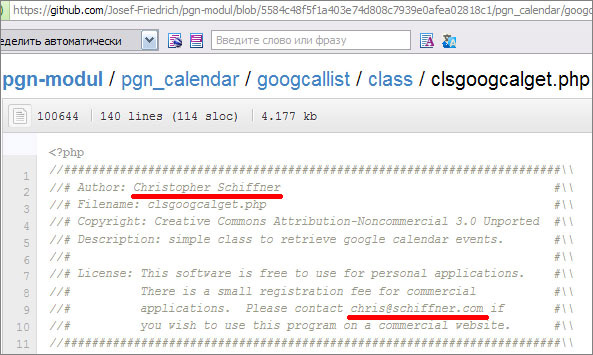
- « »
, . , http://www.ed.ac.uk/schools-departments/biology/people?option=inst&inst=1&cw_xml=menu.php . , , , , lara crossland edinburgh email.
- «»
Typically, large firms and companies use the same approach in creating personal email of employees. For example, vineeta.durani@us.ibm.com is a typical email from an IBM employee. Therefore, if there is a need to find the email of a person who works in this company, you can substitute the first and last name in the email and use it as a request to Google. If everything is correct, it will be reflected in the issue. However, practice shows that the lack of email in search results does not mean that it does not exist. It can be placed on pages that are closed from indexing, or not placed on the network at all. In this case, you can check this email for validity through an online service.
«email**domen.com» «name**domen.com». email , , , email . - - . , «»: «email***domen.com», «email****domen.com».
, email Lia P Davis, IBM, «Lia P Davis**ibm.com», email Chris Ramsdale, Google- «Chris Ramsdale**google.com».
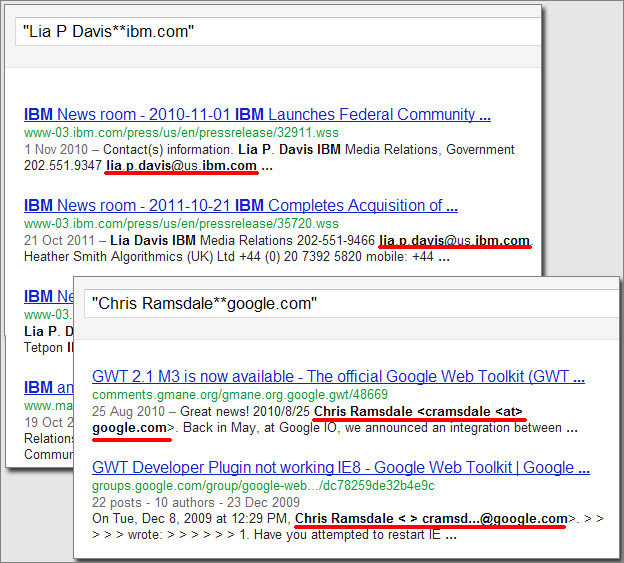
http://www.tineye.com/ . Google Chrome TinEye Reverse Image Search . , .
, http://www.blogherald.com/author/david/ David Krug (, ). .

4. email
email , . email , , .
1. Paul Bloom http://www.huffingtonpost.com/paul-bloom/how-green-is-your-smartphone_b_1123205.html?ref=technology Paul Bloom . «» «CTO Telecom Research, IBM».
, : Paul Bloom CTO Telecom Research IBM email

email ( , ), «CTO Telecom Research, IBM» , email .
2. Daniel Lim http://www.slashgear.com/new-lenses-from-sigma-50-150mm-and-70-200mm-038813/ . http://www.slashgear.com/about/ . : Daniel Lim slashgear.com email.

Email , - http://www.slashgear.com/introducing-our-photo-genius-daniel-lim-052333/ . email.
3. Deck Hazen, http://mintywhite.com/author/deck/ http://www.hazen.co.nz/ .
- http://www.hazen.co.nz/
- : site:hazen.co.nz intext:@hazen.co.nz
- http://www.who.is/website-information/hazen.co.nz/ deck@hazen.co.nz
- : Deck Hazen hazen.co.nz email

email deck.hazen@gmail.com
4. Antonella Napolitano, http://techpresident.com/blogs/antonella-napolitano .
- http://techpresident.com/blogs/antonella-napolitano - .
- . «About us» http://personaldemocracy.com/node/21444 ( - ).
- Antonella Napolitano (Europe Editor), email . http://svaroschi.blogspot.com/ .
- . email. anapolitano@gmail.com .

5. Ryan E. Smith http://people.uis.edu/rschr1/et/?p=2909 . email:
- , . http://www.jewishjournal.com/education/article/using_laptops_offers_lessons_in_ethics_of_technology_20110817/ .
- . , (). . «» http://www.jewishjournal.com/newspaper/contact_us/ . Ryan E. Smith. .
- http://www.jewishjournal.com/current_edition/ , . , (Los Angeles) . http://www.jewishjournal.com/about/author/68157/
- . .
- , , : Ryan E. Smith jewishjournal.com email . email .
- , .
- - Los Angeles: Ryan E. Smith jewishjournal.com Los Angeles email . email .
- , :
- Ryan E.Smith jewishjournal.com Los Angeles email
- Ryan E.Smith jewishjournal.com Los Angeles
- RyanE.Smith jewishjournal.com Los Angeles — ( http://twitter.com/readryansmith , :«Sign up for Twitter to follow Ryan Smith (@ReadRyanSmith).… as matzah ball soup, and they've got a restaurant riding on it. jewishjournal.com /food/article/s…… Name Ryan Smith ; Location Greater Los Angeles ; Web www.readry . ...»
- http://twitter.com/readryansmith , , http://www.readryansmith.com/ .
- «Resume» , The Jewish Journal of Greater Los Angeles, Los Angeles (2010-present)
- «About Me» email.
- - rysmith@bex.net. Email , - rysmith3@yahoo.com.
- email , http://www.validateemailaddress.org/ . rysmith@bex.net- «» email, . rysmith3@yahoo.com- .
5. email: ,
email — (STD) (http://www.apps.ietf.org/rfc/stdlist.html).
Email 2 :
- @- . , (!#$%&'*+-/=?^_`{|}~). Email, (, , ), , .

email +. «» email. email username domen .com + ( ), — , , , .. , username+office domen .com, username+work domen .com, username+forum domen .com.

. email .
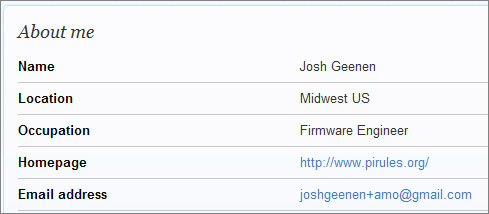
email +, — joshgeenen@gmail.com. email. “” email, (http://css.its.psu.edu/news/nlsp05/emailplus.html).
email 2-5%. .
- email. email (at @, dot .). email , email. Google Docs (https://docs.google.com):
- email;
- “”;
- “ ”;
- « » , «» ( );
- « »;
- email, , . . , , “” email (hostmaster@; domain_administrators@; dnsadmin@; domainadmin@; @domainactive.com).
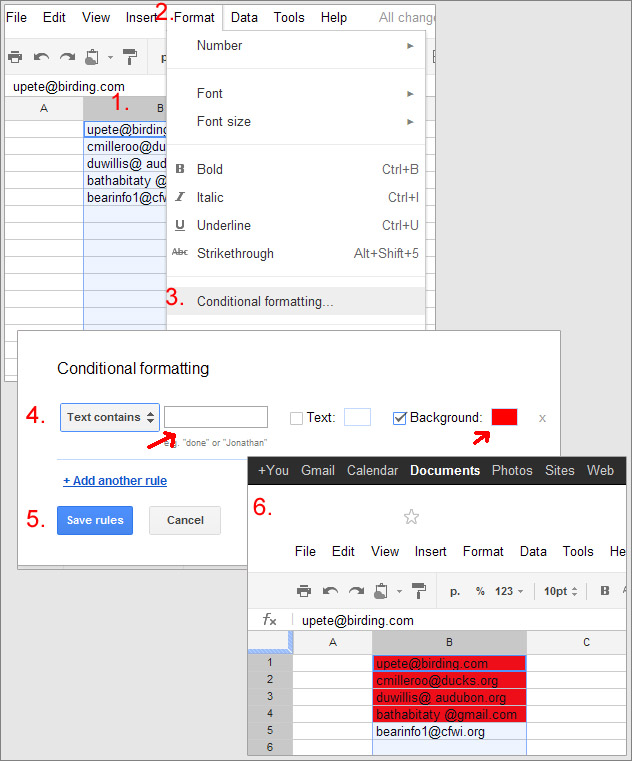
- email (,.; '). email , “” . , “envirovet@vetmed.illinois.edu;”, “jwalton@stlzoo.org.” ( ) Google Docs.
- (..). email.
- @. email ( email , @).
email - . , email. , http://www.validateemailaddress.org/ , http://verify-email.org/ , http://www.ip-address.org/verify/email-checker.php . , .. . , , http://verify-email.org/ email + (joshgeenen+amo@gmail.com) , — .
6. ,
- ( Ctrl + F) @, Google. .
- , email , , .
- email . , .
- , , , , .. , .
7.
1. email 1992 — 2011 ..
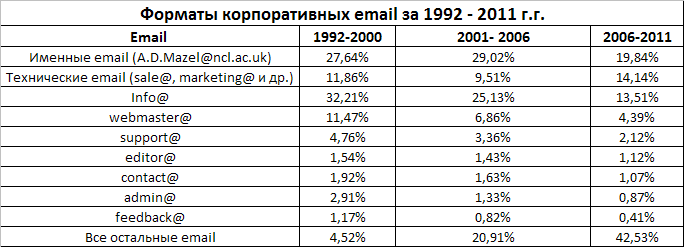
2. email
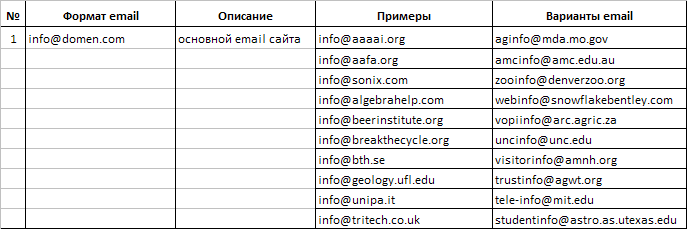








Translated from English, source: webhostinggeeks.com
PDF: Book of Emails
Source: https://habr.com/ru/post/142843/
All Articles